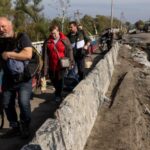
Arizona resident Simin Karimi, 78, considers her husband’s 1981 death an indirect result of the Islamic Republic of Iran’s enforcement of the Muslim headscarf for women.
A 51-year-old physician, Karimi’s husband, Dr. Parviz Moshkriz, was the director of a hospital in Tehran and suffered a ruptured aortic aneurism when a government officer assaulted him over whether the nurses’ headscarves and their work garments covered enough.
Karimi, now a linguistics professor at the University of Arizona, moved to the U.S. after becoming widowed and has lived in the Tucson area since her hiring in 1990. She grew up in Iran not wearing a female Muslim headscarf, or hijab. Then the Islamic Republic, which she and her husband considered a dictatorship, took over in the late 1970s and mandated women wear a hijab in public.
Iranian women’s “rights were taken away from us by forcing us to do something that was very personal,” Karimi said. “Nobody had the right to do that.”
Karimi and other Arizonans from Iran or of Iranian descent spoke with The Arizona Republic about their support for the mass protests that have erupted throughout the Middle Eastern country in response to the Sept. 16 death of 22-year-old Mahsa Amini while in theocratic state custody. Amini was stopped by so-called morality police for the offense of her hair being visible under her headscarf.
Women in the protests have burned their headscarves and cut their hair. As of Monday, 76 protestors have been killed by Iranian security forces, according to the Norway-based organization Iran Human Rights.
There have been worldwide demonstrations against the government as there have been in Tucson and Tempe. A solidarity rally and a memorial vigil were held Saturday evening at the Arizona State University Bridge.
“The Iranian people have been under a lot of pressure during the last 43 years and it has gotten worse,” Karimi said, adding Iranian youth are “totally hopeless” because of the regime’s human rights violations and handling of the economy.
“I’m extremely proud of the younger generation who are doing this,” she said, “resisting the dictatorship and protesting against the regime.”
Phoenix City Councilwoman Yassamin Ansari, 30, shares Karimi’s admiration for the movement’s young leadership. Arizona’s first elected official of Iranian heritage, Ansari said she is most concerned with the protests losing momentum after crackdowns, as happened during mass protests in 2009 and 2019.
Young Iranians “are rising up even though they know that it could mean death for them,” Ansari said. “It is so important this time around to make sure the international community shows support, shows solidarity with Iranian women and everybody who’s fighting for truly basic freedoms that they’re not getting.”
Born in the U.S., Ansari last visited Iran when she was 18. She said it was oppressive, being forced to wear a hijab.
“I remember being incredibly frustrated by that and very angry about it,” Ansari said.
For a few decades, Karimi would return to Iran as a guest lecturer at universities. When on campus, it was common for her to be accosted by a government officer on grounds she was not wearing an appropriate hijab. She said she is certain she was being targeted because she was someone from outside Iran.
Religious persecution led Dr. Baharak Tabarsi and her family to flee Iran when she was 10 in the 1980s. The family found asylum in the U.S. and the Phoenix physician has not returned since. There is a “sense of pride of ‘look at what these young women, as well as women of all ages, are doing to fight against oppression and fight for justice and women’s rights,’” Tabarsi said.
That said, Tabarsi’s feelings are tinged with sadness for the loss of life, she said.
Phoenix-born Ali Scotten, 42, would frequently visit his mother’s home country of Iran as a child. Scotten is the Arizona chapter president of the National Iranian American Council (NIAC), a nonprofit advocating on behalf of the community’s interests.
NIAC “supports the Iranian people’s fight for their freedom and condemns any kind of oppression by the Iranian regime against its people,” Scotten said, describing the government as “autocratic” and “repressive.”
Iran has a long history of civic activism going back generations, Scotten said. He pointed out protests in response to Amini’s death have seen attacks on Islamic Republic symbols and the burning of posters of the country’s supreme leader, Ayatollah Ali Khamenei.
“A lot of the anger is against the clerical establishment. Especially because of what sparked this round was this enforcement of religious law,” Scotten said.
Despite the direction Iran’s civil unrest has taken, said Scotten, there is little expectation the protests will bring lasting change.
“I haven’t really talked to anybody who feels like this is gonna be a big sea change in Iran, unfortunately,” Scotten said.
Karimi, however, voiced optimism.
“Because people don’t have anything to lose, I think something might happen,” she said.
Reach breaking news reporter Jose R. Gonzalez at jose.gonzalez@gannett.com or on Twitter @jrgzztx.
Support local journalism. Subscribe to azcentral.com today.
This article originally appeared on Arizona Republic: Arizona women of Iranian heritage rally in support of hijab protests




